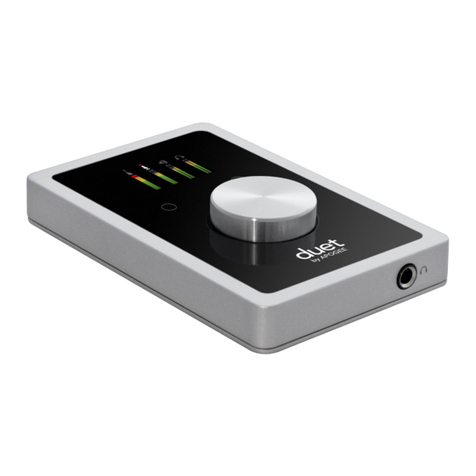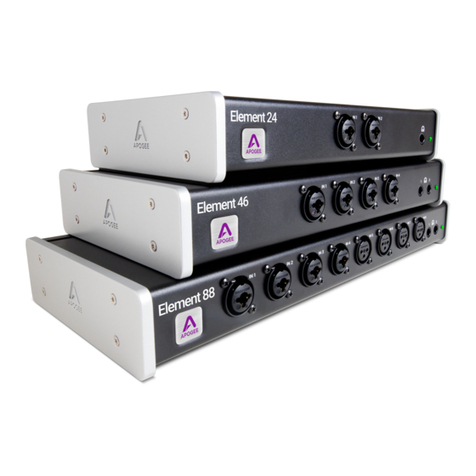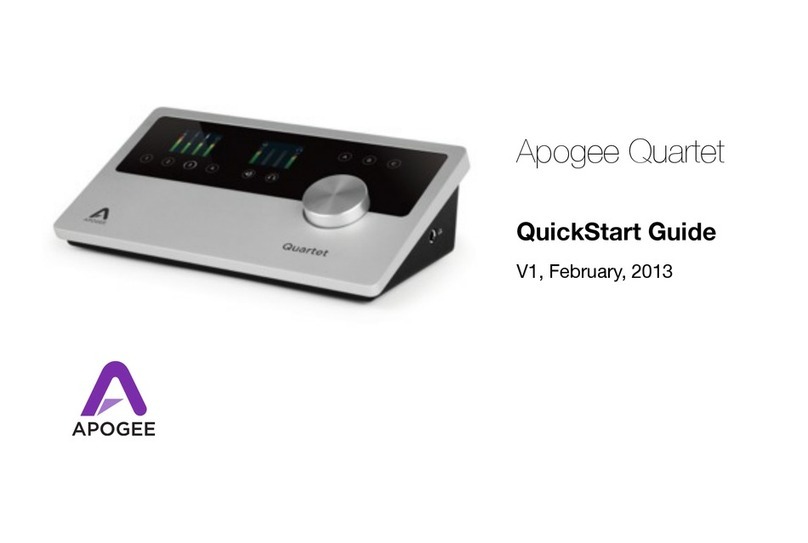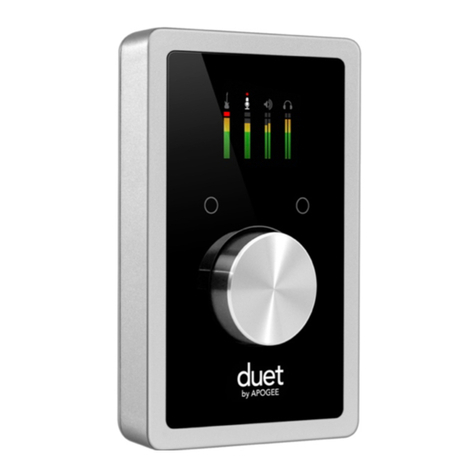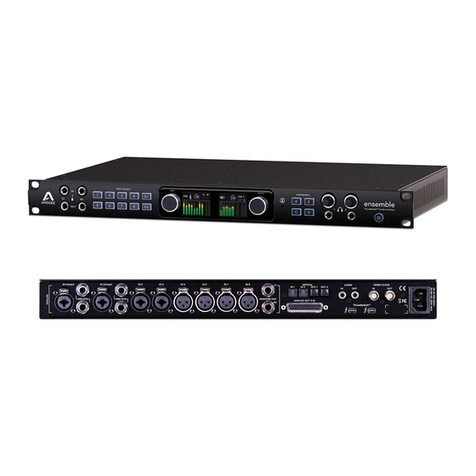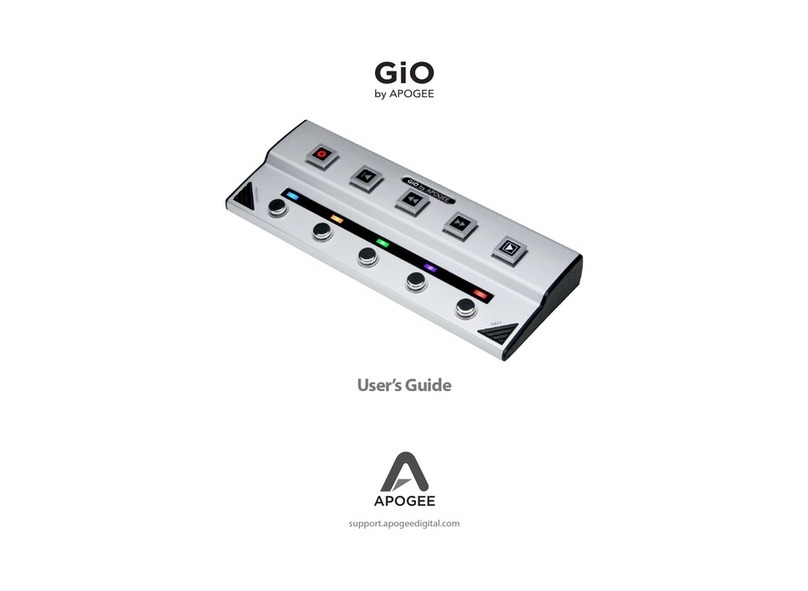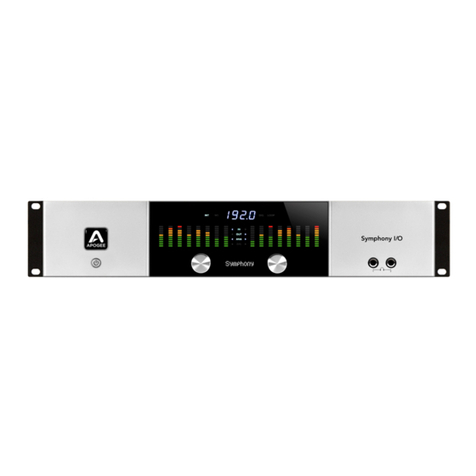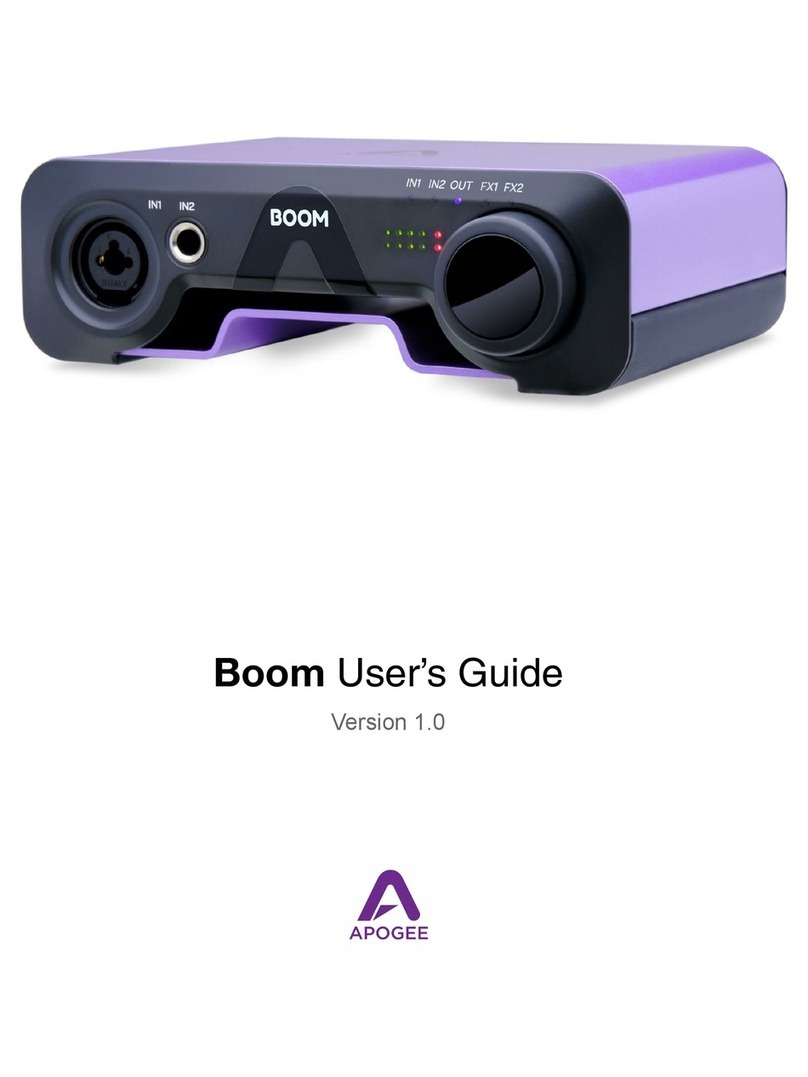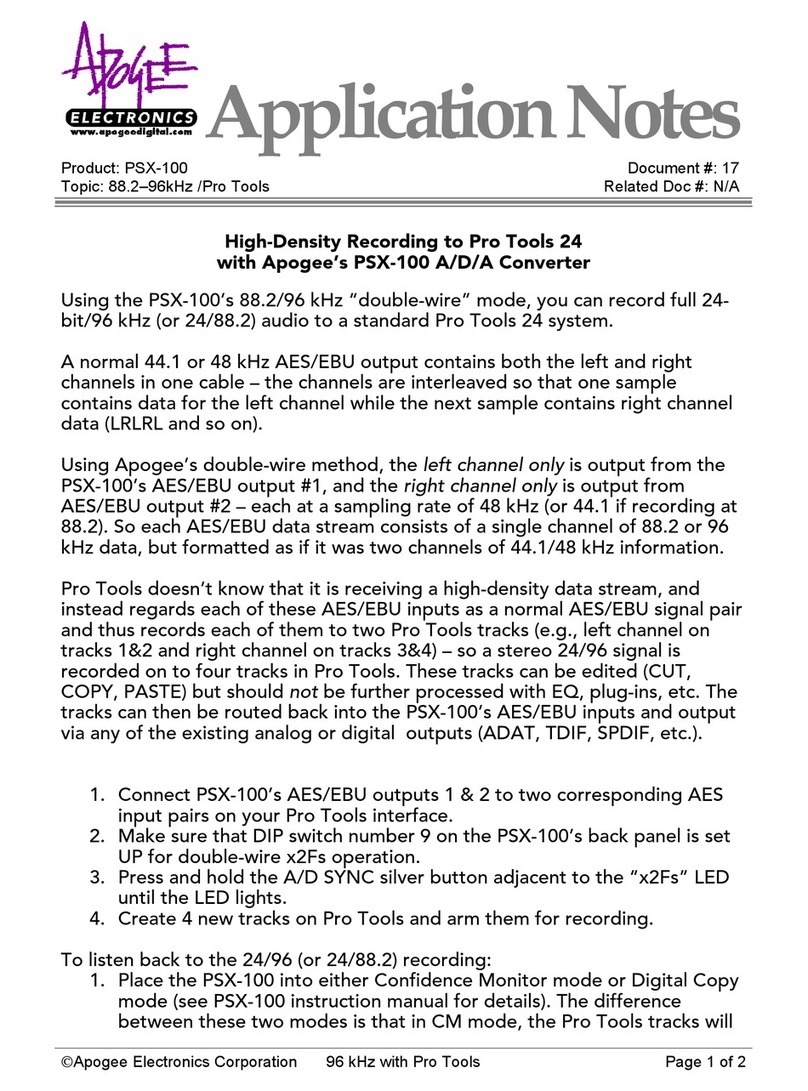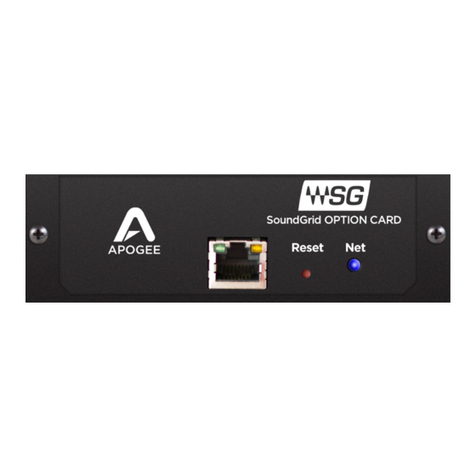line drivers simulate transformer behavior.
The circuitry is an ultra low output
impedance/high current driver, capable of
running levels up to 26 dBu to the most com-
plex or low impedance loads. This translates
into seamless integration with vintage equip-
ment.
The Symphony PCI card was designed
specifically for the Apple Mac. It is a 24-
bit/192-kHz PCI-e card that provides 32
simultaneous channels of digital I/O. Up to
three Symphony cards can be installed in one
Mac, making it possible to have 96 simultane-
ous inputs and outputs running natively with-
in a single computer. A 192-channel (96 in and
96 out) I/O setup requires six AD-16X boxes
and six DA-16Xs. And configuring the AD-
16X and DA-16X to “Advanced” routing
allows additional hardware (converters, digi-
tal effects, etc.) to be connected via the
AD/DA’s digital I/O.
The heart of the Symphony System is the
Maestro software. This software application,
while not required, provides undeniably valu-
able control of Apogee interfaces by allowing
the user to adjust hardware settings, configure
routing between hardware I/O and audio
software I/O, and to perform low-latency
mixes of hardware I/O paths and software
outputs. Maestro consists of two main win-
dows, the “Settings” window and the
“Routing/Mixer” window. Maestro also
includes functionality for checking Ensemble
software and firmware versions, personaliz-
ing “modifier” keys when setting the mixer,
and saving and recalling routing and mixer
configurations.
The Settings windows allows the user to
toggle between the Apogee interfaces that are
connected to the Symphony PCI card, set the
clock source for the selected unit, configure
the VBus, and configure the Performance
Tuning. The V-Bus feature,
employing Apogee’s ultra-
fast Symphony driver, pro-
vides unlimited routing possi-
bilities across multiple appli-
cations in any Symphony
System. This makes recording
out of QuickTime or Final Cut
Pro directly into your DAW a
breeze. The Maestro Control
Panel allows the virtual chan-
nels to be enabled. The V-Bus channel names
are clearly labeled and the number of addi-
tional V-Bus channels is selectable within
Apple’s Audio Midi Setup. Logic users will
love this feature because it makes it possible to
record bus outputs within Logic Pro. VBus
offers zero latency performance with minimal
processing power on up to 32 buses per
Symphony card, ensuring maximum audio
performance.
Maestro’s Performance Tuning feature pro-
vides the ability to fine tune the performance
of the Symphony driver to allow super low
latency for high performance platforms. This
gives the user the ability to maximize the per-
formance of the Symphony system on all sup-
ported hardware.
The Routing/Mixer Window has three
panes labeled “Input,” “Output” and “Mixer.”
Like the Setting window, each of the
Routing/Mixer panes has a “Unit Select” tab
that allows the user to toggle between the
Apogee interfaces that are connected to the
Symphony PCI card.
The Input routing pane consists of a rout-
ing grid that plots the various connections
between hardware inputs and signal paths to
software applications. These connections
appear as inputs within the software applica-
tions. It is also possible to send one hardware
input simultaneously to several software sig-
nal paths. The hardware inputs are represent-
ed by a row at the top of the grid, while paths
to software are represented by the column to
the left of the grid.
Signal paths to software may be configured
as Mono or Stereo within the “Matrix” column
of drop down menus. The Mono setting allows
for the greatest routing flexibility, but the
Stereo setting offers the convenience of routing
signals a pair at a time. I found that the Stereo
generally worked best for all of my applica-
tions, but it was nice to have the option of con-
figuring the paths as mono if required. The sig-
nal paths can be labeled in the Input column.
The Output routing pane is almost the
same functionally as the Input pane but it is
used to make connections
between signal paths from
software applications and
hardware outputs. Hardware
outputs are represented by a
row at the top of the grid,
while the column to the left of
the grid represents paths
from software. In the Matrix
column of drop down menus,
signal paths from software
may be configured as Mono or Stereo. The
Mono setting, like the Input pane, allows for
the greatest routing flexibility, while the Stereo
setting offers the convenience of routing sig-
nals a pair at a time. A path may be set to Off
in this menu as well. Signal paths may be
labeled in the Output text box. If the AD16X is
set to Standard routing, there will be no paths
listed in the Output pane as there is only one
signal path (analog inputs to all digital out-
puts). When it is set to Advanced routing, the
Input pane is used to route the AD16X’s ana-
log inputs to software inputs and the Output
pane is used to route software app outputs to
the AD16X’s AES and ADAT/SMUX outputs.
There will likewise be no paths listed in the
Input pane if a connected DA16X is set to
“Standard” routing.
The “Maestro” mixer blends the hardware
inputs with the software application playback
and routes the mix directly to hardware out-
puts. The “Mixer Select” (A-B) drop down
menu selects between the two available mix-
ers per hardware interface. The “Input
Channels” provide the ability to control
inputs to the mixer. Hardware inputs of the
selected interface are the source for these
input channels. The mixer always displays 18
inputs; the unused mixer channels are grayed
out if the selected device is equipped with less
than 18 inputs. The mixer inputs each have
“Pan,” “Level,” “Solo” and “Mute” controls.
A bar graph style meter displays the pre-fader
input level.
The “DAW Return” is a stereo input that
provides level control, metering and mute/solo
functions for the DAW Return signal, e.g. the
mix of playback tracks from the software app.
The “Main Output” is a stereo channel that pro-
Copyright 2007 JRS Publishing (USA), Inc. Reprinted with permission.
Reprinted from Pro Audio Review
Apogee Symphony Card
| APPLE OF THE REVIEWER’S EYE
The Apple Mac Pro included with my
review setup was, by a large margin, the
best computer that I’ve ever used. It worked
perfectly, was lightning fast and, quite
frankly, made me drool. If I had the money
(or even enough room on my credit card) it
would have found a permanent home in my
studio. The Symphony System, even con-
sidering the Mac Pro’s price tag, is about
half the price of a Pro Tools rig of similar
specifications.
| HERE’S A CLOSER LOOK AT THE
COMPUTER
■Mac Pro w/Dual-Core 3-GHz Intel
Xeon processors
■L2 Cache (per processor): 4 MB
■Memory: 4 GB
■Bus Speed: 1.33 GHz
■465 GB internal drive
■1.36 TB internal raid
